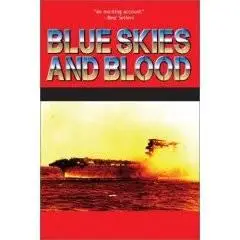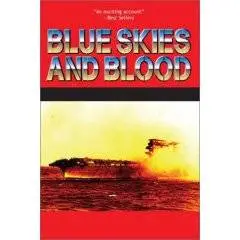Blue Skies and Blood: The Battle of the Coral Sea by Edwin P. Hoyt
I Books | ISBN: 0743458354 | Feb 2003 | Pages 240 | HTML, Jpgs in Rar | 1,7Mb
I Books | ISBN: 0743458354 | Feb 2003 | Pages 240 | HTML, Jpgs in Rar | 1,7Mb
The first definitive account of one of the most critical naval battles of World War II in the Pacific!
Spring 1942: Following the Japanese attack on Pearl Harbor, America was reeling under the successive Japanese victories in Singapore, Hong Kong, the Philippines and more. Desperate to stop what was seen as an inexorable Japanese advance toward Australia, the weak U.S. Navy intercepted the larger Japanese fleet in the Coral Sea. The Battle of the Coral Sea ushered a new era in sea warfare. For the first time ever opposing fleets used carrier-launched aircraft to fight each other. It was a fight that would determine the future of the war.
7 of 7 people found the following review helpful:
America's First Naval Victory Over The Japanese, July 8, 2003
By Jeffrey T. Munson (Dixon, IL) - See all my reviews
In May, 1942, the Japanese developed a plan to capture Port Moresby and Australia. A powerful Japanese fleet sailed into the bright blue waters of the Coral Sea. However, unknown to the Japanese, the Americans, through the efforts of their code-breakers, knew the number and types of ships in the Japanese force and they sent their own force to halt the Japanese advance.
This was the first naval battle fought where the opposing sides never saw one another. The Americans, under the command of Admiral Frank Jack Fletcher, stuck first at the Japanese, sinking a light aircraft carrier. An ironic note occurred here as the two air strike forces actually passed each other, but neither side sighted the other. The Japanese had greater success, sinking the carrier Lexington and damaging the Yorktown. In the end, this turned out to be a tactical victory for the Japanese due to the greater American shipping losses, but it was a strategic victory for the Americans because the Japanese forces were forced to withdraw, never threatening Port Moresby or Australia again.
I enjoyed this book very much. The description of the battle is very good, and the author pays great attention to detail. Perhaps my favorite part of the book involves the struggle of the oiler Neosho and the destroyer Sims, both attacked by the Japanese because they were mistaken for aircraft carriers. The author devotes several chapters to the heroic struggle of these tiny ships and their survivors.
This battle changed the outcome of the war for both the Japanese and Americans. After this battle, the Japanese never regained the offensive in the Pacific, while the Americans began the long road to Tokyo.
1 of 1 people found the following review helpful:
Excellent History, March 23, 2007
By John P. Rooney "John" (Plymouth, MA USA-America's Hometown) - See all my reviews
"Blue Skies And Blood" by Edwin P. Hoyt. Subtitled: "The Battle Of The Coral Sea". Paul S. Eriksson, Inc. New York, 1975.
If you query Amazon.Com you will find that Edwin P. Hoyt has written some 80+ books, many dealing with naval battles and some with infantry warfare. He has also written biographies, e.g. President Grover Cleveland and President James A. Garfield.
In this book, he deals with the Battle of the Coral Sea, May 1942; he has dedicated the book to Admiral Arleigh Burke, who made his reputation with destroyers in the South Pacific. Coral Sea was the first sea battle in which the opposing vessels never sighted their enemies and in which aircraft did all the damage. Just as the Battle of Lepanto (1571) signaled the change in sea power from galleys (rowed by men) to sailing vessels, the Battle of the Coral Sea marked the switch from the big guns to air power.
Using official documents of both the U.S. Navy and the Imperial Japanese Navy, Edwin Hoyt has produce a well-written record of what went on in the Coral Sea, just north of Australia . The author also relied upon interviews with war correspondent, Stanley Johnson, who was "embedded", as we now say, on board the USS Lexington. Stanley Johnson wrote the book, "Queen Of The Flat Tops", (1942). It seems to me, that while Hoyt has an excellent ability to recount and interpret the battle's historical facts, the author is also able to bring alive the persons who actually were involved. Their experiences become vivid in his writing.
The author has paid particular attention to Navy tanker, "Neosho" and her escort, the destroyer "Sims", which were sunk by IJN aircraft as a prelude to sinking of the "USS Lexington" and the Japanese carrier, "Shoho". I get the impression that Mr. Hoyt considers the Battle of the Coral Sea to be just as important as the naval battle of Midway, June 1942, in which four IJN aircraft carriers were sunk. At various places in the book, Hoyt makes the points that Coral Sea was the first sea battle in the opponents used only carrier aircraft, it was the first sea battle in which the Japanese were set back, if not defeated, and Coral Sea stopped the bombing of and the impending invasion of Australia by Japanese forces.
This book is not only an excellent historical record of the events, but it also makes alive the participants, from the lowliest seaman to the admirals.
3 of 3 people found the following review helpful:
The Japanese are checked in the Coral Sea., September 5, 2003
By A Customer
Hoyt has written several books about WWII. This is a rather short book and summarizes the battle. The Japanese lost the light carrier Shoho and the Americans lost the fleet carrier Lexington, plus a destroyer and an oiler. However, the Japanese were turned back from their objective of Port Moresby and lost the use of two carriers in the next battle Midway. So therefore the Japanese suffered their first setback and the effects of two additional carriers at Midway may have tipped the balance. After Midway, the Japanese were on the defensive.
I would have liked a little more information about the battle, but Hoyt in this book is only summarizing the battle. I like his saga of the oiler Neosho and how this wreck drifted several miles before the crew were rescued. Also lacking was the Japanese perspective of the battle. Hoyt does give some info from this perspective, but I felt it was too little.
Overall a good read, about a little written about battle. Everyone has heard about Pearl Harbor and Midway but few have heard about the Battle of the Coral Sea. The battle resulted in the loss of the Lady Lex, but checked the Japanese for the first time.
Thanks to SPIKE for the file :-)



